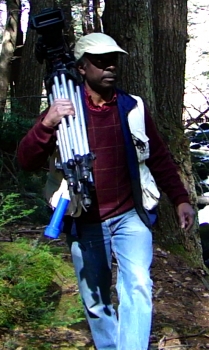You are here
Interview with "First Contact" artist Roberto Mighty
The week before "First Contact" opened in the Fisher Museum, I caught up with artist-in-residence Roberto Mighty to find out more about what connects him to this landscape and this project.
What drew you to creating this project?
First Contact has occupied my thoughts every day and night for close to 18 months. It combines my interests in science, history, anthropology, theology and economics. I love the outdoors, and I've been lucky enough to spend over a year filming and recording sound in a beautiful forest. My dual Harvard Forest appointment as Artist-in-Residence and Video Producer [see HF science outreach videos] allowed me to spend hours with ecological scientists. I got to know them and their fascinating work. Casual conversations over coffee and hikes helped give me scientific context for this entire project.
My undergraduate degree was in history, so it was exciting to spend months reading the letters, sermons, books and court records of the early English colonial settlers. My parents used to take me to Native American powwows when I was growing up, so it was fascinating to work with the Nipmuc Nation linguist and cultural specialist. Finally, as a theater buff, it was startling to make the connection between the Puritans and Will Shakespeare - who were contemporaries in England. The world's top British specialists in original pronunciation of Elizabethan English agreed to advise and work with me. Besides providing outstanding voiceovers, they gave me cultural context that I couldn't readily get from the history books.
Once I was grounded in these scientific and historical facts, it made it easier to relax and let the art come forth.
For Native Americans, the 1600s was a time of continuing a remarkably successful relationship with their local environment -- a symbiosis that had gone on for thousands of years. For Europeans, that era was a time of exploration, discovery and the search for extractive resources around the world. The two groups had completely different views of their covenant with the divine around nature, humans and landscape. This affected every aspect of their lives. Puritans and Native Americans struggled to reconcile this conflict for decades, and then in 1675, King Philip's war provided a final military solution to the conflict over the land.
In the past, you have worked in cities. Is there something in particular about this landscape that inspires you?
Although I've worked in cities in the past, I lived in Alaska when I was a kid, on the edge of a truly wild frontier. I have strong memories of growing up on the air force base with my dad, mom and older brothers. When we weren't in school, we were hiking, fishing and camping. So I love the outdoors, especially forests. The central Massachusetts plateau is gorgeous. More people should come visit. But please stay on the trails...
Did you encounter any surprises while working on this project?
The biggest surprise I had during this project was that, for the first few months, I got lost in the forest almost every time I went there! I finally swallowed my pride and bought a hiking GPS.
And I was surprised at how deeply I was touched by the history. I sometimes found myself crying as I read the letters, pamphlets and court records from the 1600s. In the very beginning, the Puritans and the Native Americans tried to coexist. But gradually, it became obvious that one group would have to go. Most people can see the sadness in this. As an Afro-latin descendant of former slaves, I found it particularly resonant.
What do you hope visitors take away from this exhibit?
I hope visitors will leave my exhibit with a deeper emotional connection to and reverence for our land and especially for our inland forests. I also want people to know more about the Puritans and the Native Americans than I was taught in school as a child. This is very important, since issues of land use, ethnic cleansing and government by theocracy continue to affect our world today. We need to be thoughtful about managing our wild lands while also providing for economic development. This isn't easy, but I believe that any development dialogue should begin with the deeply held value that we are stewards of the land and thus need to take the long view. I also can report, with great joy, that the Native Americans, while greatly reduced in numbers, are still here in America, and in fact still living in central Massachusetts.
What’s next?
My next projects include publishing a First Contact ebook; collaborating with the Actor's Shakespeare Company on their exciting, modern version of MacBeth; finishing my documentary about female comedians across America; and applying for grants to create more multimedia installations involving science, history, humans and landscape all over the world. It's addictive, you know....

